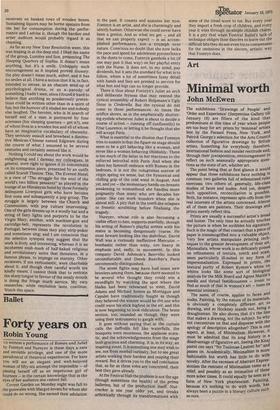Art
Minimal worth
John McEwen
The exhibitions "Drawings of People' and 'Order and Experience' (Serpentine Gallery till January 18) are fillers of the kind that predominate at this time of year when people are too busy for art: prints by 'minimal' artists lent by the Parasol Press, New York, and Patrick George's selection for the Arts Council collection of figurative drawings by British artists. Something for everybody therefore, international fashion and insular rectitude and, through their juxtaposition, encouragement to reflect on such seasonally appropriate questions as the state of art, whither art.
The point being that at first glance it would appear that these exhibitions have nothing in common: two galleries full of solemnised ruler exercises; two others of, generally, life-class studies of faces and nudes. And yet, despite such opposition, reconciliation is possible. Both, for instance, represent spin-offs from the real interests of the artists concerned. Almost all of them are painters. Their drawings and prints merely reflect this.
Prints are usually a successful artist's bread and butter. The only time he actually touches the picture is when he scribbles his signature. Such is the magic of that contact that a piece of paper is transmogrified into a valuable object. Very few artists manipulate printing techniques to the greater development of their art. Minimalists, whose work is so delicately poised on refinements of texture, touch and scale, seem particularly ill-suited to any form of impersonalisation. Expressed in prints, the textural purity of Robert Ryman's white. on whites looks like some sort of biological analysis for the Milk Board and Agnes Martin s needle and thread fastidiousness — ironic to find so much of that in women's art — loses its essential intimacy. The same, of course, applies to faces and nudes. Painting, by the nature of its materials, is obviously a completely different art to drawing, and so Hockney stands out, being a draughtsman. He also shows that it's the line that makes a drawing, not the subject. So why not concentrate on that and dispense with the apology of description altogether? This is one aspect, at least, of Minimalism. However, It must be admitted that its long history is a, disadvantage of figurative art. Seeing the Kitaj pastel one says "No Toulouse-Lautrec he and passes on. Academically, Minimalism is more fashionable but worth has little to do with novelty. After the excesses of Abstract Expressionism the restraint of Minimalism came as a relief, and possibly as an intimation of these more sober times. It could equally be seen as a form of New York phariseeism. Painting, because it's nothing to do with words, has always been a puzzle in a literary culture suc as ours.h


























 Previous page
Previous page